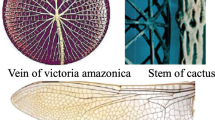Abstract
With increasing concern over the excessive energy consumption and environment pollution, structural bionics is a viable new tool of lightweight design by mechanical engineers. The structural solutions derived from nature can be successfully transferred into technical construction for maximum structural efficiency from minimal resources. The goal of the study is to develop a standard methodology for bionic mechanical structures with dead-load reduction and performance improvement. Similarity theory and fuzzy assessment method are deployed for selection of analogical samples and analysis based on structure, loading and function similarities. The type spectrum of lightweight design is established for selection convenience and principle extraction, vital to concept designs. Finite element method is used as an effective tool for mechanical performance simulation and comparison. The rapid prototyping, investment casting and Numerical Control (NC) machining are discussed for model fabrication. The static and dynamic test results indicate that the bionic models are lighter but stiffer than the original ones. So by mimicking biological structural principles, the structural bionic design offers a new solution for updating traditional design concepts and achieving maximum structural efficiency.
Similar content being viewed by others
References
Yoseph B C. Biomimetics—using nature to inspire human innovation. Bioinspiration & Biomimetics, 2006, 1, 1–12.
Vincent J F V. Making a mechanical organism being the fourth in a series of essays on the materials of nature. Journal of Bionic Engineering, 2006, 3, 43–58.
Bhushan B. Biomimetics: lessons from nature–an overview. Philosophical Transactions of Royal Society A, 2009,367, 1445–1486.
Dai Z D, Tong J, Ren L Q. Researches and developments of biomimetics in tribology. Chinese Science Bulletion, 2006, 51, 2681–2689.
Mattheck C. Teacher tree: the evolution of notch shape optimization from complex to simple. Engineering Fracture Mechanics, 2006, 73, 1732–1742.
Markus M, Thomas S, Olga S, Thomas S, Heinrich P. Biomimetics and technical textiles: Solving engineering problems with the help of nature’s wisdom. American Journal of Botany, 2006, 93, 1455–1465.
Speck T, Masselter T, Prüm B, Speckl O, Luchsinger R, Fink S. Plants as concept generators for biomimetic light-weight structures with variable stiffness and self-repair mechanisms. Journal of Bionics Engineering, 2004, 1, 199–205.
Cai K, Chen B S, Zhang H W, Jiao S. Stiffness design of continuum structures by a bionics topology optimization method. Journal of Applied Mechanics, 2008, 75, 1–11.
Zhao L, Chen W Y, Ma J F, Yang Y B. Structural bionic design and experimental verification of a machine tool column. Journal of Bionic Engineering, 2008, 5(suppl), 46–52.
Ma J F, Chen W Y, Zhao L, Zhao D H. Bionic design of aircraft reinforced frame based on structure of dragonfly wing. Acta Aeronautica ET Astronautica Sinica, 2009, 30, 562–569. (in Chinese)
Barthelat F. Biomimetics for next generation materials. Philosophical Transactions of the Royal Society of London, 2007,365 (A), 2907–2919.
Mattheck C, Burkhardt S. A new method of structural shape optimization based on biological growth. International Journal of Fatigue, 1990, 12, 185–190.
Turner C H, Anne V, Pidaparti R M V. A uniform strain criterion for trabecular bone adaptation: Do continuum-level strain gradients drive adaptation? Journal of Biomechanics, 1997, 30, 555–563.
Jang I G, Kim I Y. Computational study of Wolff’s law with trabecular architecture in the human proximal femur using topology optimization. Journal of Biomechanics, 2008, 41, 2353–2361.
Vincent J F V, Mann D L. Systematic technology transfer from biology to engineering. Philosophical Transactions of the Royal Society of London A, 2002, 360, 159–173.
Author information
Authors and Affiliations
Corresponding author
Rights and permissions
About this article
Cite this article
Zhao, L., Ma, J., Wang, T. et al. Lightweight Design of Mechanical Structures based on Structural Bionic Methodology. J Bionic Eng 7 (Suppl 4), S224–S231 (2010). https://doi.org/10.1016/S1672-6529(09)60239-0
Published:
Issue Date:
DOI: https://doi.org/10.1016/S1672-6529(09)60239-0




